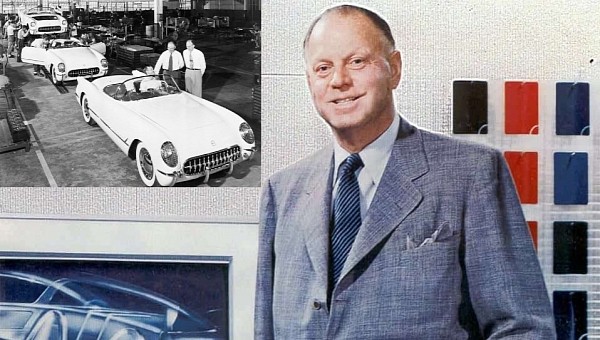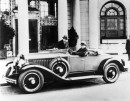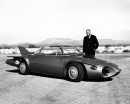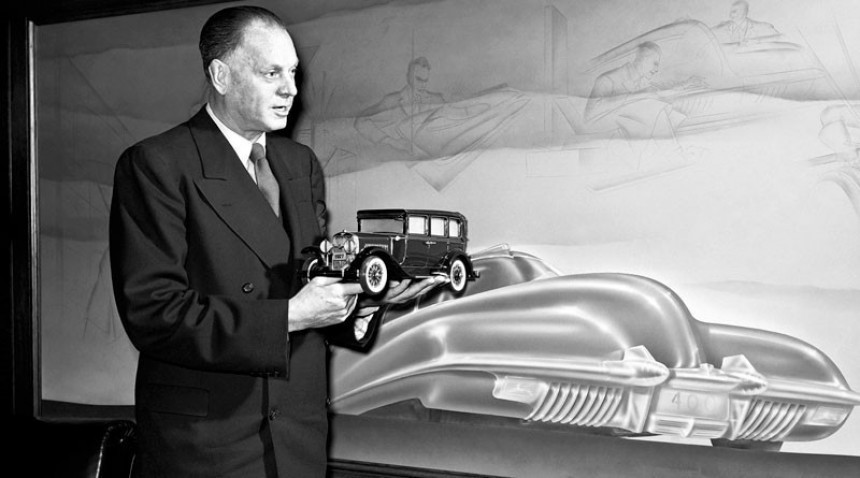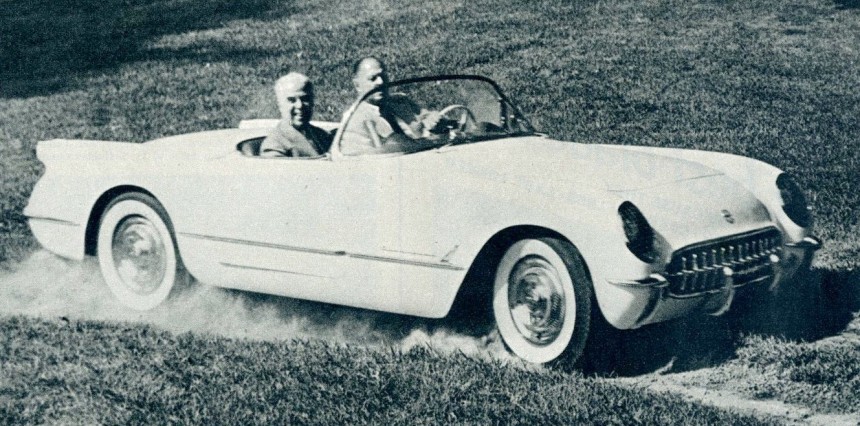In the era of the mid-engined C8 Corvette, it's easy to give all the credit to the man who wanted to move the engine from front to back in the first place. That man would be the incomparable Zora Arkus-Duntov. But make no mistake. Though Arkus-Duntov was the father of the mid-engined Vette, he wasn't the car's inventor.
That title belongs to a man that, had he not designed the C1 Corvette, would still have an auto industry resume that makes modern auto executives jealous. His name was Harley Jarvis Earl. Make no mistake, Harley Earl's exploits are well-known and well-celebrated in enthusiast circles. But to say he is a household name in the same vein as Enzo Ferrari or Carrol Shelby wouldn't be entirely accurate.
That's a shame if you ask us. So if you're in the camp of not knowing who the heck Harley Earl is, consider this your crash course. This is a condensed cut of the remarkable story of the man behind the Corvette. You could argue that the man was born to design cars by looking at what his father, Jacob William Earl's occupation entailed. That being a fabricator of custom-built coach bodies for horse-drawn carriages.
By the time Harley was born on November 22nd, 1893, his father hadn't yet earned the rank of one of the most skilled carriage fabricators in the family's native Southern California. After a brief venture as a carpenter after leaving his native Michigan for California, the elder Earl found work at a Los Angeles carriage assembler. Before too long, Harley's father was a partner in the business. Soon after, he bought out the whole darn operation and changed its name to Earl Carriage Works.
By venturing down that career path, Harley's father inadvertently sent his son down the path to greatness. By 1900, it was abundantly clear that the horse's centuries of hard toil were at an end. All at the hands of internal combustion. All the while, the adolescent Harley was already helping out around the shop, putting carriages together. It's only fitting that when J.W. Earl changed the name of his business to Earl Automotive Works, Harley took to it like a duck to water.
It's said that the young Harley Earl once used the clay sediment left over from recently receded floods to sculpt his very first automotive mockups. At least, according to his brother Arthur. It may have seemed bizarre to his family at the time. But wouldn't you know, the time period the Earl's decision to change the family business coincided with the rise of Hollywood. Suddenly, the shop had no shortage of work, with film studios across Southern California needing prop vehicles in their dozens or even hundreds.
These being Hollywood actors, directors, and producers, people in the film industry often took the cars home with them. Though many of his more famous clientele have fallen out of the limelight in the last century, the company's most famous client, Roscoe "Fatty" Arbuckle's 168-inch (4,267 mm) wheelbase Pierce-Arrow Cruiser took over a year to manufacture, is by far the highlight of Harley Earl's work during this time. If you're wondering, that's around 30 inches (762 mm) longer than a modern Escalade ESV.
With a reputation that thoroughly preceded him by this juncture, it wouldn't take long for General Motors to come knocking. At some point, either just before or after 1920, the Earl family business was bought outright by a man called Don Lee. Lee was perhaps the most influential Cadillac dealer on the entire American West Coast. Lee was wise enough to keep Harley as the shop's lead designer in the short term, but he was soon discovered by the higher-ups at the Fisher Body company.
Fisher was a little-remembered coachbuilding division of GM which subcontracted with their luxury divisions to provide their bodywork. The company was perhaps most famous for building the P-75 Eagle prototype fighter during World War II. Though the P-75 turned out to be a terrible airplane that more or less doomed the company, Laurence P Fisher's idea to put Harley Earl in charge of design for the LaSalle luxury division was equally a stroke of genius.
The 1928 LaSalle Phaeton bridged the gap between Buick and Cadillac in a similar way to how GMC and their Denali line do today. Granted, the LaSalle brand was more fit for a jazz group than a hip-hop video. So it's not exactly an apples-to-apples comparison. Early designed the LaSalle from his newly acquired office in GM's Detroit headquarters, leaving sunny California for a life in the heart of Mo-Town.
He finished it all in under three months, a scarcely believable figure by modern standards, doing so using rough sketches and clay models to take the best features of other luxury cars and add his own distinctly American spin on it. Earl later remarked that a contemporary Hispano-Suiza H6 was instrumental in inspiring the LaSalle's design. It turned out to be his first big-time automotive smash hit. This prompted GM's head honcho Alfred P. Sloan to anoint Earl as the head of GM's new Art and Color design team.
Though the Great Depression no doubt put a downer on proceedings, Harley Earl never stopped innovating. Taking inspiration from Bentleys of the era, his design for the 1933 Pontiac during this time ensured the brand would stave off elimination for another 75 years or so. Throughout the 30s, Working under Earl during his time as VP of the GM's Art and Color Section was one of the most stressful jobs in all of Detroit.
His subordinates found it aloof that though Earl no doubt had an eye for design, his artistic abilities were, at best, not all that flushed out. That said, you'd never have guessed that based on the looks of Earl's second most famous creation behind the Corvette, the Buick Y-Job. As the first concept vehicle by the modern definition, the Y-Job, futuristic pop-up headlamps and all, was a landmark vehicle for reasons that should be obvious. It's just one of dozens of concepts to his credit across the GM lineup.
Though Earl retired in 1958, Arkus-Duntov ensured the Corvette would far outlive its designers with the bewitchingly beautiful C2 Corvette. By the time Harley Earl retired, General Motors was the largest auto manufacturer in the world by a significant margin. He died on April 10th, 1969, aged 75.
It was Harley Earl that laid the foundations for a modern automotive landscape where function often follows form rather than vice-versa. An industry where designers, sculptors, and graphical artists are just as important as engineers. In a world where we buy cars as much with our eyes as we do our wallets, that's kind of important.
Check back soon for more from Corvette Month here on autoevolution.
That's a shame if you ask us. So if you're in the camp of not knowing who the heck Harley Earl is, consider this your crash course. This is a condensed cut of the remarkable story of the man behind the Corvette. You could argue that the man was born to design cars by looking at what his father, Jacob William Earl's occupation entailed. That being a fabricator of custom-built coach bodies for horse-drawn carriages.
By the time Harley was born on November 22nd, 1893, his father hadn't yet earned the rank of one of the most skilled carriage fabricators in the family's native Southern California. After a brief venture as a carpenter after leaving his native Michigan for California, the elder Earl found work at a Los Angeles carriage assembler. Before too long, Harley's father was a partner in the business. Soon after, he bought out the whole darn operation and changed its name to Earl Carriage Works.
By venturing down that career path, Harley's father inadvertently sent his son down the path to greatness. By 1900, it was abundantly clear that the horse's centuries of hard toil were at an end. All at the hands of internal combustion. All the while, the adolescent Harley was already helping out around the shop, putting carriages together. It's only fitting that when J.W. Earl changed the name of his business to Earl Automotive Works, Harley took to it like a duck to water.
These being Hollywood actors, directors, and producers, people in the film industry often took the cars home with them. Though many of his more famous clientele have fallen out of the limelight in the last century, the company's most famous client, Roscoe "Fatty" Arbuckle's 168-inch (4,267 mm) wheelbase Pierce-Arrow Cruiser took over a year to manufacture, is by far the highlight of Harley Earl's work during this time. If you're wondering, that's around 30 inches (762 mm) longer than a modern Escalade ESV.
With a reputation that thoroughly preceded him by this juncture, it wouldn't take long for General Motors to come knocking. At some point, either just before or after 1920, the Earl family business was bought outright by a man called Don Lee. Lee was perhaps the most influential Cadillac dealer on the entire American West Coast. Lee was wise enough to keep Harley as the shop's lead designer in the short term, but he was soon discovered by the higher-ups at the Fisher Body company.
Fisher was a little-remembered coachbuilding division of GM which subcontracted with their luxury divisions to provide their bodywork. The company was perhaps most famous for building the P-75 Eagle prototype fighter during World War II. Though the P-75 turned out to be a terrible airplane that more or less doomed the company, Laurence P Fisher's idea to put Harley Earl in charge of design for the LaSalle luxury division was equally a stroke of genius.
He finished it all in under three months, a scarcely believable figure by modern standards, doing so using rough sketches and clay models to take the best features of other luxury cars and add his own distinctly American spin on it. Earl later remarked that a contemporary Hispano-Suiza H6 was instrumental in inspiring the LaSalle's design. It turned out to be his first big-time automotive smash hit. This prompted GM's head honcho Alfred P. Sloan to anoint Earl as the head of GM's new Art and Color design team.
Though the Great Depression no doubt put a downer on proceedings, Harley Earl never stopped innovating. Taking inspiration from Bentleys of the era, his design for the 1933 Pontiac during this time ensured the brand would stave off elimination for another 75 years or so. Throughout the 30s, Working under Earl during his time as VP of the GM's Art and Color Section was one of the most stressful jobs in all of Detroit.
His subordinates found it aloof that though Earl no doubt had an eye for design, his artistic abilities were, at best, not all that flushed out. That said, you'd never have guessed that based on the looks of Earl's second most famous creation behind the Corvette, the Buick Y-Job. As the first concept vehicle by the modern definition, the Y-Job, futuristic pop-up headlamps and all, was a landmark vehicle for reasons that should be obvious. It's just one of dozens of concepts to his credit across the GM lineup.
Further innovations with vehicle camouflage during World War II, the advent of factory two-tone paint, and Cadillac's iconic tailfins of the 50s and 60s can all be attributed to Earl as well. Not to mention the iconic mid-to-late 50's Chevy Bel Air and all its relatives to top things off. All the while, Earl integrated some of his favorite attributes of European car design into an American paradigm that wound up printing money for GM. Of course, his most famous case of applying European design techniques to an American design is none other than the Corvette.
Inspired by Jaguars, Aston Martins, Mercedes-Benzes, and BMWs from the early '50s, "Project Opel," as it was known, took a sleek, sporty body and shoved the best internals GM had to offer underneath. Chevy GM Ed Cole approved Earl's design, in what can only be described in automotive terms as being quicker than Harley could get the words out. The same year the C1 Corvette launched in 1953, Zora-Arkus Duntov was hired by GM as an engineering assistant.
Inspired by Jaguars, Aston Martins, Mercedes-Benzes, and BMWs from the early '50s, "Project Opel," as it was known, took a sleek, sporty body and shoved the best internals GM had to offer underneath. Chevy GM Ed Cole approved Earl's design, in what can only be described in automotive terms as being quicker than Harley could get the words out. The same year the C1 Corvette launched in 1953, Zora-Arkus Duntov was hired by GM as an engineering assistant.
Though Earl retired in 1958, Arkus-Duntov ensured the Corvette would far outlive its designers with the bewitchingly beautiful C2 Corvette. By the time Harley Earl retired, General Motors was the largest auto manufacturer in the world by a significant margin. He died on April 10th, 1969, aged 75.
It was Harley Earl that laid the foundations for a modern automotive landscape where function often follows form rather than vice-versa. An industry where designers, sculptors, and graphical artists are just as important as engineers. In a world where we buy cars as much with our eyes as we do our wallets, that's kind of important.
